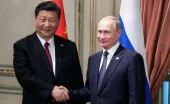Molly Minturn - My family is heartbroken to share that my father died in surgery on Monday, Feb. 10. It…
India June 2024-
Written by Diana Thebaud Nicholson // January 25, 2025 // India // Comments Off on India June 2024-
Republic Day Diplomacy: Decoding Indonesian President Subianto’s Delhi Sojourn
With the Indonesian strongman Prabowo Subianto in Delhi, the geopolitical ball is in PM Narendra Modi’s court.
C Uday Bhaskar
(The Quint) India celebrated its first Republic Day on 26 January 1950 – and in keeping with the fervour of the end of the colonial rule in southern Asia and the enthusiastic embrace of non-alignment by like-minded nations in that heady era, it was appropriate that the chief guest at the first-ever parade was the then Indonesian President Sukarno.
Seventy five years later, another Indonesian President has been accorded this honour, testifying to the historic legacy of the bilateral relationship and the potential it has for consolidating the national interests of both nations in the current decade.
Collectively, ASEAN accounts for 11 percent of India’s total global trade and it is diminutive Singapore, the city-state with which Delhi has the most comprehensive regional partnership, that is India’s largest trading partner.
Indonesia is in second place with bilateral trade touching $29.4 billion in financial year 2023-24 – and the balance of trade is visibly in Jakarta’s favour.
For two proximate nations whose combined GDP is in excess of $5 trillion, a bilateral trade figure of under $30 billion points to the vast potential for steady growth. Subianto’s visit will thus hopefully prove to be the catalyst.
2 January
Narendra Modi’s Populist Facade Is Cracking
India is now a testing ground for whether demagoguery or deteriorating living conditions exert a greater sway on voters.
By Robert F. Worth
(The Atlantic) … India has been living on hype. Its leaders manufacture bigger promises every year: India as an economic titan, a spiritual leader, a world power capable of standing alongside China, Russia, Europe, and America. Modi’s enablers describe him as a “civilizational figure”—someone who stands above politics, who will use his country’s demographic weight to rewrite the rules of the global economy. … Even Modi’s abundant critics have focused mostly on his Muslim-baiting and his democratic backsliding, as if prepared to concede what they see as his managerial skill.
But the election results and their aftermath hint at a crack in Modi’s populist facade and a spreading discontent with his economic and political record. India’s growth has been heavily weighted toward the wealthy, who have become exponentially richer on Modi’s watch. …
At the same time, eight in 10 Indians live in poverty. Extraordinary numbers are out of work; one estimate puts unemployment among those aged 15 to 24 at more than 45 percent (though other estimates run lower). Instead of moving from farms to seek employment in cities, as people in other developing countries have done, many Indians—unable to find factory or service jobs—are making the trek in reverse, even as farm income stagnates and drought turns fields into deserts.
2024
26 December
India’s former prime minister Manmohan Singh, architect of economic reforms, dies at 92
(AP) — India’s former Prime Minister Manmohan Singh, widely regarded as the architect of India’s economic reform program and a landmark nuclear deal with the United States, has died. He was 92.
… A mild-mannered technocrat, Singh became one of India’s longest-serving prime ministers for 10 years and leader of the Congress Party in the Parliament’s Upper House, earning a reputation as a man of great personal integrity. He was chosen to fill the role in 2004 by Sonia Gandhi, the widow of assassinated Prime Minister Rajiv Gandhi.
Singh was reelected in 2009, but his second term as prime minister was clouded by financial scandals and corruption charges over the organization of the 2010 Commonwealth Games. This led to the Congress Party’s crushing defeat in the 2014 national election by the Hindu nationalist Bharatiya Janata Party under the leadership of Narendra Modi.
Former Indian prime minister Manmohan Singh dies aged 92
(The Guardian) … Singh, called India’s “reluctant prime minister” due to his shyness and preference for being behind the scenes, was considered an unlikely choice to lead the world’s biggest democracy. But when Congress leader Sonia Gandhi led her party to a surprise victory in 2004, she turned to Singh to be prime minister.
Famed for his trademark sky-blue turbans and home-spun white kurta pyjamas, Singh became the country’s first non-Hindu prime minister. He served a rare full two terms as prime minister in India’s tumultuous politics and is credited with spurring the rapid economic growth that lifted tens of millions of Indians from poverty.
…he won scholarships to study economics at Cambridge and later at Oxford, where he earned a doctorate.
He went on to hold pivotal government roles including serving as head of India’s central bank. Later, he worked for the International Monetary Fund.
Singh was pitchforked into politics in 1991 when India, facing one of the worst-ever economic crises, was on the brink of default. The then prime minister, PV Narasimha Rao, drafted Singh to be his finance minister.
In a seismic shift, Singh broke away from India’s Soviet-style economic planning model. … He dismantled the restrictive “license raj” which dictated the products factories could make and what types of bread could be sold, devalued the rupee to boost exports, opened key industrial sectors to private and foreign investment, and slashed taxes. The bold steps ushered in rapid growth, earning Singh the moniker of India’s economic “liberator”.
The same deft economic hand marked his first term as prime minister. He presided over an economy that grew at more than 8%, championed landmark initiatives such as the Indo-US civil nuclear deal which ended India’s nuclear isolation, and launched ambitious social welfare programmes. But his second term was marred by a string of massive corruption scandals that eroded public trust in his administration.
16-20 August
India Sets Up National Task Force After Rape and Murder of Doctor
India’s top court has set up a national task force for doctors to help with the safety of their staff, according to the Associated Press.
Zero-tolerance approach a must to curb crimes against women
The plight of victims in high-profile rape cases and the relief accorded by the state to the accused are stark in cases such as that of Bilkis Bano.
C Uday Bhaskar
“India’s rape statistics indicate that 90 such dastardly incidents are reported daily. This may be relatively low by global standards — as per an estimate, India reports 1.8 rape cases per 100,000 population, while the figures for Botswana and South Africa are 92.9 and 72.1, respectively. However, this is callous justification for the deplorable trends related to the security and safety of women and the girl child over the past two decades.”
(The Tribune India)THE horrific gangrape and murder of a junior doctor at a medical college and hospital in Kolkata has triggered national outrage. This was reflected in Prime Minister Narendra Modi’s Independence Day address.
Alluding to the incident, Modi said: “I would like to express my pain once again, from the Red Fort today. As a society, we will have to think seriously about the atrocities against women that are happening — there is outrage against this in the country. I can feel this outrage. The country, society and state governments will have to take this seriously.” He added that such cases of crime against women should be investigated speedily “and those responsible should be punished without delay”.
The victim in the Kolkata case is being referred to as Abhaya by her shell-shocked colleagues, recalling the horrific 2012 Delhi gangrape-murder that was termed the ‘Nirbhaya’ case; it took eight years before the perpetrators were finally brought to justice in March 2020.
Kolkata doctor rape and murder case: Indian medics call for nationwide strike
West Bengal Chief Minister Mamata Banerjee to lead rally calling for justice
13 August
Protesting Kolkata doctors claim cover-up in killing of trainee Indian medic after arrest
Striking staff say more than one person was probably involved in the crime and are pushing for compensation for her family
Thousands of resident doctors across India have stepped up strike action over an alleged government cover-up in the rape and murder of a trainee medic, disrupting patient care in state-run hospitals nationwide.
A 31-year-old resident doctor was killed on Friday at RG Kar Medical College and Hospital in Kolkata, West Bengal, while she was on shift.
Her body was found in the state-run hospital bearing numerous injuries and she had been sexually assaulted, local media reported.
Police have arrested a civic volunteer, who has reportedly confessed to the crime, but protesting doctors claim more people were involved in the crime and the alleged cover-up. Resident doctors are graduate doctors who are receiving on-the-job training at government-run hospitals.
Sexual violence against women is a widespread problem in India, where an average of nearly 90 rapes a day were reported in 2022. A survey by the Indian Medical Association found 75 per cent of doctors in India have faced some form of violence.
11 August
Unregulated vigilante armies push Indian state of Manipur to brink of civil war
Thousands of rifles are in the hands of civilian militia who freely mobilise every night, with police and the state accused of being powerless
(The Guardian) The violence in Manipur began last May with clashes between the majority Meitei and the minority Kukis-Zo tribes over the removal of special minority privileges for the Kuki community. Since then, it has escalated into an ongoing ethnic conflict which has killed over 220 people and displaced over 60,000 as whole villages were burned to the ground, while women reported sexual assault and rape.
An unofficial border dividing the state down ethnic lines – Kuki-Zo on one side and Meitei on the other – has become a hardened frontline, created and fiercely guarded by civilian militia groups from both communities. Thousands of guns, many sophisticated rifles stolen from state armouries, are now in the hands of these unregulated vigilante civilian armies who freely mobilise every night to protect their own turf. The police and the state stand accused of being both complicit and unwilling to intervene.
23 July
A weakened Narendra Modi subsidises jobs and doles out pork
The prime minister has had to compromise after a disappointing election
(The Economist) Narendra Modi…was brimming with confidence when his government unveiled an interim budget in February. With a general election a few weeks away, his ruling Bharatiya Janata Party (BJP) was widely expected to retain, and possibly expand, its majority in parliament. Such was his sureness of victory that the mini-budget contained few of the welfare handouts and other sops that often precede Indian elections. It focused instead on trimming the fiscal deficit, improving infrastructure and other measures aimed at a long-term goal to make India a developed nation by 2047, the centenary of its independence.
A new political reality infused the full budget, unveiled on July 23rd. It was the first since the election result in June, in which the BJP lost its majority, forcing it to rely on coalition partners to form a government. That unexpected shift in India’s political landscape—attributed largely to public anger over unemployment, inflation and inequality—was evident in the budget in several ways.
10 June
New Hope for India’s Democracy
Jayati Ghosh
(Project Syndicate) The ruling Bharatiya Janata Party’s inability to secure a parliamentary majority in India’s general election has shattered Prime Minister Narendra Modi’s aura of invincibility. Modi will now have to rely on coalition partners to pass legislation, potentially curbing his efforts to consolidate power.
Voters have pulled Indian democracy back from the brink. While Prime Minister Narendra Modi won a third consecutive term, the failure of his ruling Bharatiya Janata Party (BJP) to secure a simple majority in the Lok Sabha, the lower house of parliament, will force Modi to rely on several unpredictable allies to promote his legislative agenda.
While domestic elites and external observers had bought into the BJP’s claims of economic prosperity, India’s supposed boom has benefited only a small segment of the population. Most Indians face declining job prospects, stagnant or falling real wages, and sharp increases in the prices of essential goods. Polls show that these issues were at the top of voters’ – and more recently, business executives’ – minds, despite efforts to distract them with divisive rhetoric. The limits of the BJP’s divisive political agenda are also becoming increasingly apparent. Throughout the election campaign, Modi and his party openly stoked Hindu fears and prejudices, claiming that the opposition Congress party would seize people’s assets and distribute them to “infiltrators” and “those who have more children” – a dog-whistle for Muslims.
8 June
India’s Rahul Gandhi nominated as opposition leader after election gains
Gandhi’s Congress party’s election results defied analysts’ expectations, and helped rehabilitate his political career.
(Al Jazeera) Rahul Gandhi, scion of the Nehru-Gandhi family that governed India for decades in the wake of independence, has been nominated to lead India’s opposition in parliament following an election result that pulled his party back from the political wilderness.
A meeting of the leadership of Congress – the leading opposition party in the country – on Saturday voted unanimously to recommend Gandhi’s election as India’s official opposition leader. The role had been left vacant since 2014.
Gandhi is the great-grandson of Jawaharlal Nehru, India’s first prime minister following independence in 1947. His grandmother, Indira Gandhi, and father, Rajiv Gandhi, also served in the role, while his mother has long been a top official for Congress
7 June
C. Uday Bhaskar: India’s shock election result shows democracy is still thriving
While the BJP’s underperformance shocked supporters and observers, Indian voters have restored hope in the country’s democratic process
(SCMP) …The welcome news for the liberal camp is that Indian democracy, which was steadily sliding towards a one-party/one-leader/one-religion template of illiberal authoritarianism since Prime Minister Narendra Modi came to power in 2014, has shown it is relatively robust and spirited.
The fear in many quarters that equitable, non-discriminatory democracy was being slowly strangled has eased. A large cross section of Indian voters used the ballot box to reject the divisive, anti-Muslim Hindutva politics that the ruling Bharatiya Janata Party (BJP) champions.
Modi’s supporters were no doubt shocked by the final election tally after most exit polls and mainstream media projections suggested an emphatic victory for the BJP.
Modi projected himself as the face of the BJP for this election. His campaign was enabled in large measure by a subservient mainstream media – derisively referred to as godi, or lapdog, media – creating a larger-than-life perception of the prime minister.
A vast cyber-constituency of pro-BJP trolls, many in the diaspora, venerated Modi’s image and subjected critics of their leader and the Hindutva agenda to vile abuse. The virus of hatred for the “other” – particularly Muslims – was injected night after night by servile journalists and their corporate owners.
Collectively, the media, influencers, pollsters and Modi’s cyber militia exuded misplaced certitude that the two-term prime minister was much loved and admired, had a divine mission to lead India to lost glory and that the voters would endorse him en masse. This did not happen, and the BJP is now in the unenviable position of having to cobble together a coalition government.
The biggest political takeaway from the election is the Indian voter definitively pricking the much-hyped Modi bubble. In recent weeks, the prime minister began describing himself as a divine emissary and suggested his birth was not biological. Even Ayodhya, where Modi consecrated an ornate temple to the Hindu god Ram, rejected the BJP candidate at the polls.
India’s much-derided opposition showed commendable determination and pre-election planning, with Congress party leader Rahul Gandhi playing a significant role. He has been portrayed as an inept princeling too politically naive to be a match for Modi, yet his cross-country Bharat Jodo (Unite India) marches reinvigorated a poisoned national polity.
Indian Surprise
By Gwynne Dyer
“Pride goeth before a fall”, says the Old Testament, so India’s Prime Minister Narendra Modi was just begging for humiliation. It duly arrived.
In ten years in office he had never held a press conference and very rarely even gave an interview, but before this election he was so confident that his BJP (Indian People’s Party) would win that he let it all hang out. In a TV interview in his own Varanasi constituency, he revealed that his birth had been a divine event.
The opinion polls said the BJP would win in a landslide, the media followed suit, and various pundits began writing about the impending demise of India’s democracy. They were all wrong.
Some voters took the long view and understood the threat Modi posed to India’s future as a united country; others just feared that the BJP was getting too big for its boots and needed to be taken down a peg – and some others, mostly not Hindus, actually feared for their lives. Together they were numerous enough to spoil Modi’s party.
India awaits results of general election marred by ‘unprecented’ disinformation
India’s six-week election was staggering in its size and logistical complexity, but also in the “unprecedented” scale of online disinformation.
(France 24) The biggest democratic exercise in history brought with it a surge of false social media posts and instant messaging, ranging from doctored videos to unrelated images with false captions.
Raqib Hameed Naik, from the US-based India Hate Lab, said they had “witnessed an unprecedented scale of disinformation” in the elections.
“Conspiracy theories… were vigorously promoted to deepen the communal divide,” said Naik, whose organisation researches hate speech and disinformation.
With seven stages of voting stretched over six weeks, AFP fact checkers carried out 40 election-related debunks across India’s political divide.
There were fake videos of Bollywood stars endorsing the opposition, as well as those purporting to show one person casting multiple votes.




